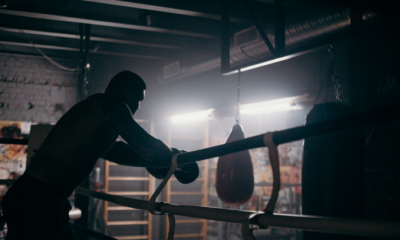Life
How to Show Up Authentically According to Sheryl Lee Ralph
Sheryl Lee Ralph’s recent Ted talk is a masterclass on exactly what it takes to show up authentically as it relates to her.

According to Ibinye Olayide (Marriage and Family Therapist):
“It’s important to show up authentically so that genuine intimacy [can be shared]. Intimacy helps people feel safe, share their struggles and their joys and develop a deep level of closeness. When we do not show up authentically…the level of closeness [within a relationship] will be limited”.
These principles are also true as it relates to cultivating a community around your brand or business because, as the old adage says, people will only do business with people that they know, like and trust. But how do we go about achieving this?
Sheryl Lee Ralph’s recent Ted talk is a masterclass on exactly what it takes to show up authentically as it relates to her.
#1 Personal styling
From your religious beliefs, nationality, favourite genre of music to your personality- “style is a way to say who you are without saying a word” (Rachel Zoe). With this in mind, it’s worth noting that Sheryl Lee Ralph was communicating before she even began her speech and that her style of dress (a blue pantsuit with a sprinkle of sequence on it, accompanied by lashes, a bold lip and sleek ponytail) was more than likely a deliberate choice.
Whether you are as deliberate about how you present yourself or not, it is important to realise that you too are sending a message to those who come across you (online or in person). One way to ensure that you are conveying the right one is to style yourself in a way that is true to who you are.
#2 Brand story
Another thing that Ralph would have contemplated before she said a word is the topic of her talk. When you consider the positive impact that she made in 2022 by winning an Emmy for best supporting actress in a comedy as a first-time nominee at the age of 66 (despite a 40 year acting career), it becomes immediately obvious why she settled upon “A 3-step Guide to Believing in Yourself”.
As she declared during her (Emmy) acceptance speech “To anyone who has ever, ever had a dream and thought your dream wasn’t, wouldn’t, couldn’t come true, I am here to tell you that this is what believing looks like”. In that moment her brand story became one of self-belief and it is that brand story that has led to increased opportunities such as her aforementioned Ted talk.
With this example in mind, it becomes clear that showing up authentically also means taking the trials and triumphs of your industry experience and sharing them in such a way that it captures your audience and causes them to take inspired action.
#3 Use of language
Apart from demonstrating how to leverage her brand story to reach a wider audience, Sheryl Lee Ralph’s Ted talk is a case study in the art of storytelling. As the old marketing adage goes, “facts tell; stories sell” so Ralph does not simply serve up the 3 steps to believing in yourself and walk off stage- she illustrates each point by telling relevant stories from her life.
One of the main ways that she does this is through the use of humour and colloquialisms such as “shooketh,” “check up from the neck up” and, at one point, employing a Jamaican accent. In so doing, she solidifies her authority, credibility and expertise in the subject matter and makes herself more relatable to her audience in the process.
What this demonstrates is that language can also be a unifying factor; so it’s important to punctuate your story with words that are authentic to you and will resonate with your ideal client as well.
#4 Unique Selling Point (USP)
Another thing that makes Sheryl Lee Ralph’s Ted Talk come alive is the way that she leverages her USP of being both an actress and singer. By using talents that come naturally to her, she is able to masterfully embody the characters and emotions that she describes within her stories and further impress her point(s) through song.
This also serves as a way to stand out from the sea of other speakers that have graced the Ted stage. Likewise, “if you don’t distinguish yourself from the crowd, you’ll just be in the crowd” (Rebecca Mark). In other words, it’s important not to conform to industry standards so much so that you fail to differentiate yourself from everyone else.
By doing this you will use “your value proposition [to] answer…the question: Why should I buy from you and not your competitor” (Neil Patel).
Since people will only do business with people that they know, like and trust, it is important to show up and represent your brand/business as authentically as possible.
This can be achieved in a number of ways including your personal style, stories and use of your innate gifts and talents (amongst other things).
It is my hope that this article will help you to implement this within your current visibility strategy.
Life
10 Research-Backed Steps to Create Real Change This New Year
This New Year could finally be the one where you break old patterns and create real, lasting change.

Every New Year, we make plans and set goals, but often repeat old patterns. (more…)
Life
9 Harsh Truths Every Young Man Must Face to Succeed in the Modern World
Before chasing success, every young man needs to face these 9 brutal realities shaping masculinity in the modern world.

Many young men today quietly battle depression, loneliness, and a sense of confusion about who they’re meant to be.
Some blame the lack of deep friendships or romantic relationships. Others feel lost in a digital world that often labels traditional masculinity as “toxic.”
But the truth is this: becoming a man in the modern age takes more than just surviving. It takes resilience, direction, and a willingness to grow even when no one’s watching.
Success doesn’t arrive by accident or luck. It’s built on discipline, sacrifice, and consistency.
Here are 9 harsh truths every young man should know if he wants to thrive, not just survive, in the digital age.
1. Never Use Your Illness as an Excuse
As Dr. Jordan B. Peterson often says, successful people don’t complain; they act.
Your illness, hardship, or struggle shouldn’t define your limits; it should define your motivation. Rest when you must, but always get back up and keep building your dreams. Motivation doesn’t appear magically. It comes after you take action.
Here are five key lessons I’ve learned from Dr. Peterson:
-
Learn to write clearly; clarity of thought makes you dangerous.
-
Read quality literature in your free time.
-
Nurture a strong relationship with your family.
-
Share your ideas publicly; your voice matters.
-
Become a “monster”, powerful, but disciplined enough to control it.
The best leaders and thinkers are grounded. They welcome criticism, adapt quickly, and keep moving forward no matter what.
2. You Can’t Please Everyone And That’s Okay
You don’t need a crowd of people to feel fulfilled. You need a few friends who genuinely accept you for who you are.
If your circle doesn’t bring out your best, it’s okay to walk away. Solitude can be a powerful teacher. It gives you space to understand what you truly want from life. Remember, successful men aren’t people-pleasers; they’re purpose-driven.
3. You Can Control the Process, Not the Outcome
Especially in creative work, writing, business, or content creation, you control effort, not results.
You might publish two articles a day, but you can’t dictate which one will go viral. Focus on mastery, not metrics. Many great writers toiled for years in obscurity before anyone noticed them. Rejection, criticism, and indifference are all part of the path.
The best creators focus on storytelling, not applause.
4. Rejection Is Never Personal
Rejection doesn’t mean you’re unworthy. It simply means your offer, idea, or timing didn’t align.
Every successful person has faced rejection repeatedly. What separates them is persistence and perspective. They see rejection as feedback, not failure. The faster you learn that truth, the faster you’ll grow.
5. Women Value Comfort and Security
Understanding women requires maturity and empathy.
Through books, lectures, and personal growth, I’ve learned that most women desire a man who is grounded, intelligent, confident, emotionally stable, and consistent. Some want humor, others intellect, but nearly all want to feel safe and supported.
Instead of chasing attention, work on self-improvement. Build competence and confidence, and the rest will follow naturally.
6. There’s No Such Thing as Failure, Only Lessons
A powerful lesson from Neuro-Linguistic Programming: failure only exists when you stop trying.
Every mistake brings data. Every setback builds wisdom. The most successful men aren’t fearless. They’ve simply learned to act despite fear.
Be proud of your scars. They’re proof you were brave enough to try.
7. Public Speaking Is an Art Form
Public speaking is one of the most valuable and underrated skills a man can master.
It’s not about perfection; it’s about connection. The best speakers tell stories, inspire confidence, and make people feel seen. They research deeply, speak honestly, and practice relentlessly.
If you can speak well, you can lead, sell, teach, and inspire. Start small, practice at work, in class, or even in front of a mirror, and watch your confidence skyrocket.
8. Teaching Is Leadership in Disguise
Great teachers are not just knowledgeable. They’re brave, compassionate, and disciplined.
Teaching forces you to articulate what you know, and in doing so, you master it at a deeper level. Whether you’re mentoring a peer, leading a team, or sharing insights online, teaching refines your purpose.
Lifelong learners become lifelong leaders.
9. Study Human Nature to Achieve Your Dreams
One of the toughest lessons to accept: most people are self-interested.
That’s not cynicism, it’s human nature. Understanding this helps you navigate relationships, business, and communication more effectively.
Everyone has a darker side, but successful people learn to channel theirs productively into discipline, creativity, and drive.
Psychology isn’t just theory; it’s a toolkit. Learn how people think, act, and decide, and you’ll know how to lead them, influence them, and even understand yourself better.
Final Thoughts
The digital age offers endless opportunities, but only to those who are willing to take responsibility, confront discomfort, and keep improving.
Becoming a man today means embracing the hard truths most avoid.
Because at the end of the day, success isn’t about luck. It’s about who you become when life tests you the most.
Change Your Mindset
The Four Types of Happiness: Which One Are You Living In?
Most people chase success only to find emptiness, this model reveals why true happiness lies somewhere else.

In a world driven by rapid technological growth and constant competition, many people unknowingly trade joy for achievement. (more…)
Change Your Mindset
The Secret Daily Routines Behind History’s Most Brilliant Thinkers
Uncover the daily rituals and hidden habits that powered history’s most brilliant minds to success.

Why Daily Rituals Matter
Every great achiever has one thing in common: discipline. Behind the novels, inventions, discoveries, and masterpieces are small, consistent habits repeated daily. (more…)
-

 Personal Development4 weeks ago
Personal Development4 weeks agoThis Silent Habit Might Be Sabotaging Your Career
-

 Business3 weeks ago
Business3 weeks agoWhy Your E-Commerce Fulfilment Is Probably Broken (And How to Fix It)
-

 Shift Your Mindset3 weeks ago
Shift Your Mindset3 weeks ago11 E’s That Define Every Great Leader And Why Most People Miss Them
-

 Did You Know2 weeks ago
Did You Know2 weeks agoThe Success Patterns You Inherited (And Didn’t Notice)
-

 Business2 weeks ago
Business2 weeks agoThe Hidden Money Pit in Your Operations (and How to Use It)
-

 Entrepreneurs2 weeks ago
Entrepreneurs2 weeks agoThe Essential Skills Every Entrepreneur Needs In 2026
-

 Change Your Mindset1 week ago
Change Your Mindset1 week agoHow to Turn Your Mind Into Your Greatest Asset (Instead of Your Enemy)
-

 Change Your Mindset5 days ago
Change Your Mindset5 days agoThe Silent Skill That Makes People Respect You Instantly


























